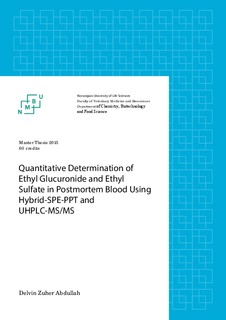| dc.contributor.author | Abdullah, Delvin Zuher | |
| dc.date.accessioned | 2015-12-03T14:24:23Z | |
| dc.date.available | 2015-12-03T14:24:23Z | |
| dc.date.issued | 2015-12-03 | |
| dc.identifier.uri | http://hdl.handle.net/11250/2366774 | |
| dc.description.abstract | Background: Alcohol misuse is associated with significant morbidity and mortality. Ethyl glucuronide (EtG) and Ethyl sulfate (EtS) are direct ethanol metabolites and powerful biomarkers for previous alcohol consumption. EtG and EtS can be determined in blood for an extended period after complete elimination of ethanol itself. Their presence is therefore indicative of recent alcohol consumption in case of delayed sampling after an event (e.g., car crash) Methods: An ultra-high performance liquid chromatography tandem mass spectrometry (UHPLC-MS/MS) method for the determination of EtG and EtS in postmortem blood was developed and validated. Postmortem blood samples (100 µL) were prepared using protein precipitation technique (PPT) with acetonitrile (ACN). Filtration of the supernatants through Hybrid SPE-PPT appeared to be necessary to reduce matrix effect (ME) caused by co-elution of phospholipids with EtG and EtS. Identification of compounds was performed using multiple reaction monitoring (MRM) in the positive mode. Deuterated analogous of EtG and EtS was used as internal standard. The compounds were separated using reversed phase chromatography C18 column (2.1 mm x 100 mm, 1.8 µm). The flow rate of 0.4 mL /min was used, 0.5 µL injected and gradient elution with 0.1% formic acid (FA) and methanol (MeOH) as organic modifier. Results: Excellent linearity for EtG from (0.4 - 100 µmol/L) and EtS from (0.2 -50 µmol/L) was achieved (R2 ≥ 0,999). Limit of detection (LOD) and limit of quantification (LOQ) were 0.04 and 0.3 µmol/L for EtG and 0.02 and 0.15 µmol/L for EtS, respectively. Accuracy (bias) and precision (relative standard deviation) were studied at four different levels of quality control (QC) samples, and were always better than ±10%. The use of the internal standard appears to be appropriate for the EtG and EtS assay and the matrix effects were found to be negligible. The method was applied on 26 DUI-cases and postmortem cases, good agreements of quantified concentrations were found for the concentrations examined. Conclusion: A sensitive and specific method for quantitative determination of EtG and EtS in postmortem blood was developed despite a simple, fast and robust with high throughput sample preparation procedure. | nb_NO |
| dc.description.sponsorship | Norwegian Institute of Public Health | nb_NO |
| dc.language.iso | eng | nb_NO |
| dc.publisher | Norwegian University of Life Sciences, Ås | |
| dc.subject | Ethyl glucuronide | nb_NO |
| dc.subject | Ethyl sulfate | nb_NO |
| dc.subject | Postmortem blood | nb_NO |
| dc.title | Quantitative determination of ethyl glucuronide and ethyl sulfate in post-mortem blood using Hybrid-SPE-PPT and UHPLC–MS/MS | nb_NO |
| dc.title.alternative | Bestemmelse av Etylglukuronid and etylsulfat i blod | nb_NO |
| dc.type | Master thesis | nb_NO |
| dc.subject.nsi | VDP::Mathematics and natural science: 400::Chemistry: 440 | nb_NO |
| dc.source.pagenumber | 63 | nb_NO |
| dc.relation.project | Norwegian Institute of Public Health | nb_NO |
| dc.description.localcode | M-KJEMI | nb_NO |
